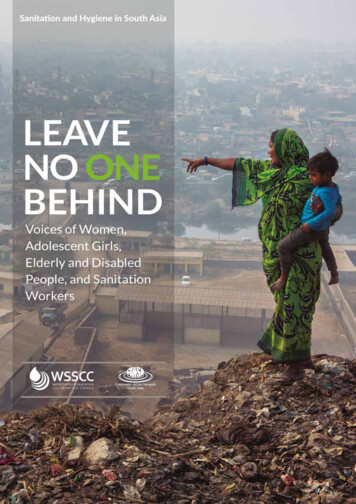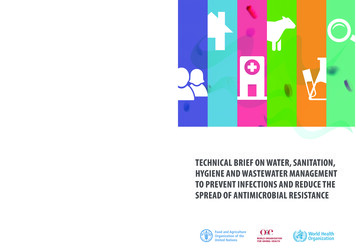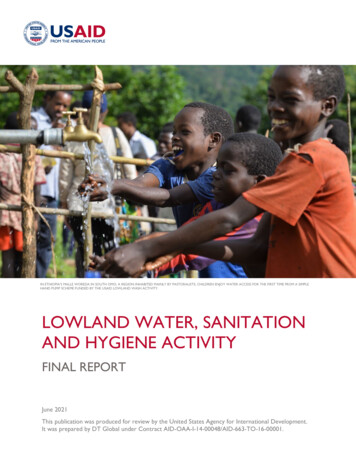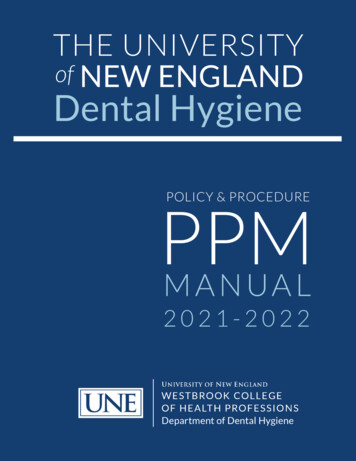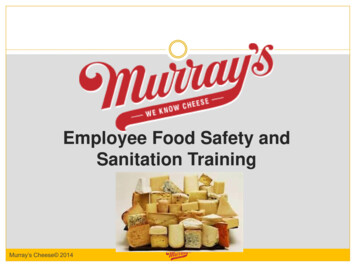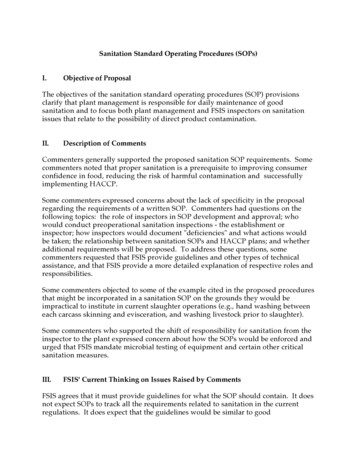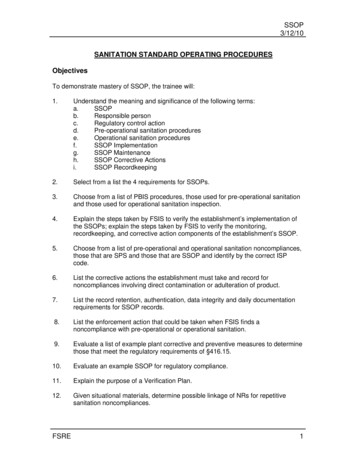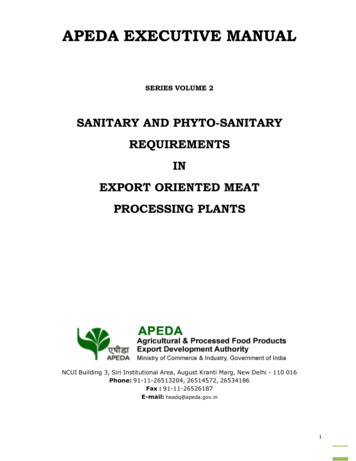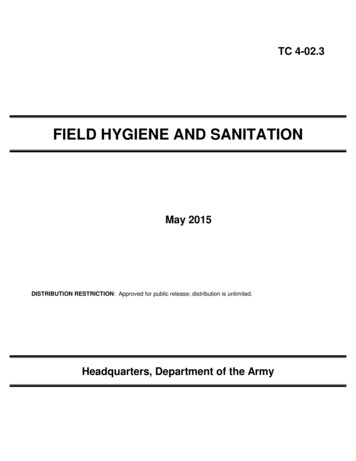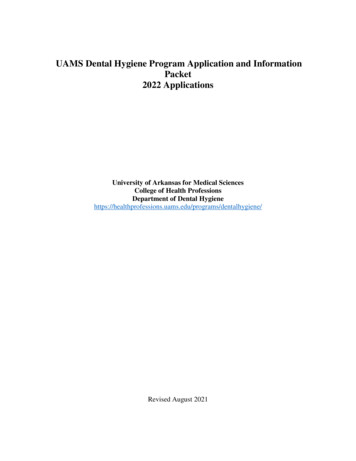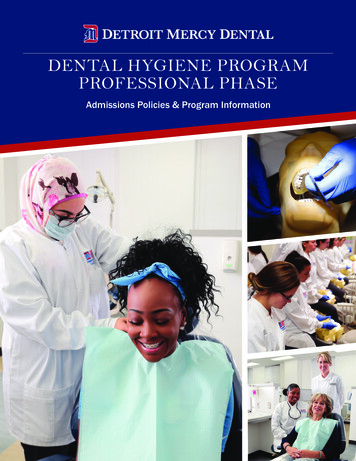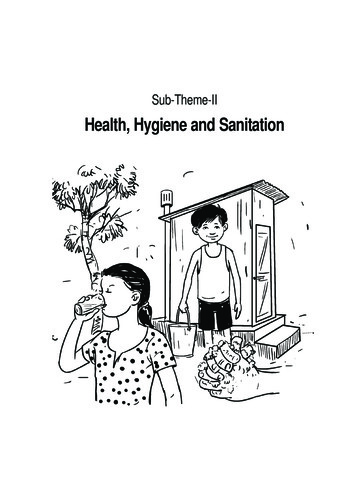
Transcription
Sub-Theme-IIHealth, Hygiene and Sanitation
Health, Hygiene and Sanitation2.1. BackgroundHealth is the level of functional and metabolicefficiency of a living organism. The World HealthOrganization (WHO-2006) defined human healthin its broader sense as “a state of completephysical, mental, and social well-being and notmerely the absence of disease or infirmity”. (http://www.who.int/governance/eb/who constitution en.pdf)Health, or health and well-being, are also includesa supportive environment, personal security,freedom of choice, social relationships, adequateemployment and income, access to educationalresources, and cultural identity (Diaz et al., 2006;Millennium Assessment 2005).Over the last decade, health promotion practitioners have increasingly been asked to thinkabout the relationships between humans and the environment in terms of ecosystems (Brown,1994) and to adopt an ‘ecological’ approach to health promotion (Kickbusch, 1989) with theenvironment an integral part of human development (Hancock, 1993a).Hygiene is a set of practices performed to preservehealth. According to the World Health Organization(WHO), “Hygiene refers to conditions and practices thathelp to maintain health and prevent the spread ofdiseases. Hygiene is a concept related to cleanliness,health and medicine. It is as well related to personaland professional care practices. In medicine andeveryday life settings, hygiene practices are employedas preventative measures to reduce the incidence andspreading of disease. Hygiene practices vary, and whatis considered acceptable in one culture might not beacceptable in another. In the manufacturing of food,pharmaceutical, cosmetic and other products, goodhygiene is a critical component of quality assurance.The terms cleanliness and hygiene are often usedinterchangeably, which can cause confusion. In general,hygiene refers to practices that prevent spread of45
disease-causing organisms. Cleaning processes (e.g., handwashing) remove infectious microbes as well as dirt and soil,and are thus often the means to achieve hygiene.Sanitation generally refers to the provision of facilities andservices for the safe disposal of human urine and feces. Theword ‘sanitation’ also refers to the maintenance of hygienicconditions, through services such as garbage collection andwastewater disposal.(WHO).Environmental sanitation envisages promotion of health of thecommunity by providing clean environment and breaking thecycle of disease. It depends on various factors that include hygiene, status of the people,types of resources available, innovative and appropriate technologies according to therequirement of the community, socioeconomic development of the country, cultural factorsrelated to environmental sanitation, political commitment, capacity building of the concernedsectors, social factors including behavioral pattern of the community, legislative measuresadopted, and others. India is still lagging far behind many countries in the field ofenvironmental sanitation.(Pandve, 2008).Ecological sanitation, which is commonly abbreviated to ecosan, is an approach, ratherthan a technology or a device which is characterized by a desire to “close the loop” (mainlyfor the nutrients and organic matter) between sanitation and agriculture in a safe manner.Put in other words: “Ecosan systems safely recycle excreta resources (plant nutrients andorganic matter) to crop production in such a way that the use of non-renewable resources isminimized”. When properly designed and operated, ecosan systems provide a hygienicallysafe, economical, and closed-loop system to convert human excreta into nutrients to bereturned to the soil, and water to be returned to the land. Ecosan is also called resourceoriented sanitationSustainable sanitation considers the entire “sanitation value chain”, from the experience ofthe user, excreta and wastewater collection methods, transportation or conveyance of waste,treatment, and reuse or disposal. The term is widely used since about 2009. In 2007the Sustainable Sanitation Alliance defined five sustainability criteria to compare thesustainability of sanitation systems. In order to be sustainable, a sanitation system has to beeconomically viable, socially acceptable, technically and institutionally appropriate, and itshould also protect the environment and the natural resourceSustainable Development – the core concept for the Post-2015 Development Agenda –provides an integrated response to the complex environmental, societal, economic andgovernance challenges that directly and disproportionately affect children. With appropriatefocus, investment and innovation, the Post-2015 Development Agenda presents anunprecedented opportunity to create a World Fit for All Children.46
The relationship between children and sustainable development is symbiotic. Progress insustainable development underpins child rights and well-being, and conversely, child rightsand well-being underpin lasting and equitable development progress. Finding the balanceto achieve progress for all in today’s world and for future generations depends upon threekey propositions:1. Sustainable development starts with safe, healthy and well-educated children;2. Safe and sustainable societies are, in turn, essential for sensitive groups such as children,women and elderly; and3. Children’s voices, choices and participation are critical for the sustainable future we want.2.2. Focus of the Sub themeThe primary objective of this sub theme is to explore, document and analyze the role ofhealth, hygiene and sanitation on the health of not only humans but of the entire ecosystemand thus its impact on sustainable development in terms of use of science, technology andinnovative approaches and ideas. The brief objectives are could be :i. Identifying the status of prevailing sanitary and hygiene conditions which affect the healthand wellbeing of living beings. This may in turn have major impact on economic productivity,since inadequate sanitation impacts individuals, households, eco systems, communitiesand nations as a whole.ii. Addressing mental health problems amongst children and adolescents which includedepression, anxiety, eating and sleeping disorders that can be attributed to several reasonssuch as decrease in physical activities, spending too much time in the virtual world whichput such children at risk of delayed emotional and social development.iii. Improving health conditions of the urban/peri-urban and rural citizens, especially children,women and elderly through providing access to safe drinking water, sanitation andintroducing preventive interventions in domestic places, workplaces and outdoors.2.3. Logical Frame workNatural & Man-made SystemsHygiene & Sanitation(Domestic/Workplace/Outdoors)Preventive & SafetyInterventionsCurative InterventionsWell-beingSocial(Physical & Mental State)EnvironmentalEconomicalFig.-2.3. Flow chart showing relationship of health, hygiene and sanitation with sustainable development47
2.4. ScopeThe strong synergies between health and nutrition (World Bank 2013) are well-documented;good health is not possible without good nutrition. Malnutrition remains one of the maindeterminants of the global burden of disease, with 45% of child mortality attributable to undernutrition (Black et. al. 2013).The major challenges faced by the sanitation sector are the lack of proper sanitation for the majority,ill effects owing to poor sanitation, water shortage and pollution, food insecurity and unplannedurban growth. The population un-served by sanitation facility is about 40% of the world population.Approximately 6000 children die every day from diarrheal diseases related to inadequate sanitationand hygiene. About 1 billion people worldwide-mostly children - are infested with intestinal wormsand as a result suffer from nutritional deficiency and poor growth. Both these groups of diseasesare mostly transmitted through unhygienic conditions. Sewage discharges are a major componentof water pollution all over the world. Only a small portion of the polluted water is treated before it isdischarged into open water channels or bodies. PollutantsComponents of SDG 6: Availibilityand Sustainable Management ofalso leak into ground water from sewers, septic tanks,Water and Satition for Allsoak pit toilets and cesspools. By 2030, more than half of6.1world population will face shortage of water.DRINKINGWATERThe sanitation practices promoted today are either basedon hiding the human excreta in deep pits (drop-andstore) or on flushing them away and diluting them inrivers, lakes and the sea (flush-and–discharge). Whereasecological sanitation is based on three fundamentalprinciples which are preventing pollution rather thanattempting to control it after we pollute; sanitizing the urineand faeces; and using the safe products for agriculturalpurposes (sanitize – and –recycle).486.5ECOSYSTEMSDG 6CLEANWATER INE6.3WATERQUALITY6.4WATER-USEEFFIENCY
Spurred on by Agenda Goals, along with changing national realities, many low and middleincome countries will need to invest heavily in sanitation in the next decade. The decisionsthey make and the approaches they take today will have far-reaching consequences forsustainability and for the well-being of their citizens.Sanitation is an integral piece of the sustainable development puzzle. The right sanitationsystems can not only minimize health and environmental risks associated with opendefecation and poorly managed waste disposal, but also, in many cases, yield multiplebenefits in areas from health to food security, resilient livelihoods, business growth, energy,and ecosystem services. The Initiative focus on “productive” sanitation approaches.Hygiene - specifically hand-washing with soap - is one of the mostimportant interventions for human health and development and is auniversal necessity. Fundamental to fighting under nutrition, reducingchild mortality, overcoming antibiotic resistance, and advancing accessto education, hygiene underpins the delivery of several other SDGsand ultimately advances gender equity, dignity, and human rights.Promotion and demonstration of safe hygiene practices – i.e., hand-washing with soap,food hygiene, menstrual hygiene management, safe stool disposal, and solid wastemanagement – at the household, community and institutional level needs to be carried outcollaboratively with the health, education, community development and business developmentsectors . The success of these programs involves ensuring that schools and health facilitiesenable the practice of safe hygiene behaviors and those health workers and educators aretrained on appropriate behavior change Communication. Developing educational andcommunication materials for WASH, and strengthening school health club programs, arealso instrumental to reinforcing hygiene promotion in schools.The concept of WASH, groups together water, sanitation, and hygiene because the impact ofdeficiencies in each area overlap strongly. Addressing these deficiencies together can achieve astrong positive impact on public health.The UN’s Millennium Development Goals included improvement of WASH services in Target 7.C:“Halve, by 2015, the proportion of the population without sustainable access to safe drinking waterand basic sanitation. This has been replaced by the Sustainable Development Goals, where Target6 aims to “ensure availability and sustainable management of water and sanitation for all”.Access to WASH, in particular safe water, adequate sanitation, and proper hygiene education,can reduce illness and death, and also affect poverty reduction and socio-economic development.Lack of sanitation contributes to approximately 700,000 child deaths every year due to diarrhea.Chronic diarrhea can have a negative effect on child development (both physical and cognitive) Inaddition, lack of WASH facilities can prevent students from attending school, impose a burden onwomen and diminish productivity.Although access to sanitation has been improving over the past decades, the World HealthOrganization (WHO) estimates that still “2.5 billion people – more than one third of the globalpopulation – live without basic sanitation facilities”. In 2015, 750 million people lacked access tosafe, clean drinking water and approximately 2,300 people die every day from diarrhoea49
Policies made in all sectors can have a profound effect on population health and healthequity. The health of people is not solely a health sector responsibility; it is also impacted byissues such as transport,agriculture, housing, trade andforeign policy. To address themulti-sectoral nature of healthdeterminants requires the politicalwill to engage the whole ofgovernment in health. The healthsector should promote “Health forAll” policy across sectors thatsystematically takes into accountthe health implications ondecisions, seeks synergies andavoids harmful health impacts inorder to improve populationhealth and health equity and address the social determinants of health.In short;l Today more than 1 billion people are chronically undernourished and food insecure.l Undernourishment compromises immune systems, which leads to a higher incidence ofillness and disease that in turn contribute to lower productivity and life expectancies.l Poor nutrition undermines economic growth. According to UNICEF, billions of childrenyounger than 5 are chronically malnourished. Chronic undernourishment in childrencreates a vicious cycle of compromised physical and cognitive development that reducestheir economic productivity when they become adults, miring people in poverty that, inturn, leads to chronic undernourishment and poor health in the next generation.l A massive disease burden is associated with deficient hygiene, sanitation, and watersupply and is largely preventable with proven, cost-effective interventions.l The total benefits of these interventions are greater than the health benefits alone andcan be valued at more than the costs of the interventions.l Hygiene, sanitation, and water supply are development priorities, yet the ambition ofinternational policy on drinking water and sanitation is inadequate.l Hygiene, sanitation, and water supply continue to have health implications in the developedworld.l The active involvement of health professionals in hygiene, sanitation, and water supplyis crucial to accelerating and consolidating progress for health.50
2.5. Project IdeasProject – 1:Bio-filtration/bio-remediation processesto improve water quality for reuseIntroductionAbout 30% of the drinking quality of water is used everyday to flush the toilets, Grey water(from kitchen, bath and wash) generated in a household if treated can be reused for flushingtoilets and gardening purposes using reed-bed (a channel filled with pebbles with aquaticplants growing on it), it would be possible to improve the quality of water for reuse.Objective1) To assess the quality and quantity of water required for different household uses2) To understand the influence of growing microbial and plant communities on the quality ofwater passing through it3) To understand the influence of residence time on the emergent water quality51
Methodology1) Collect samples of Grey water (Kitchen, Bath, Wash)and check for its quality (bacterial and physical)2) Construct a reed bed in a plastic drum by filling it withclean pebbles and planting wetland plants (plantsgrowing on the submerged edges of ponds)3) Pass the grey water from the bottom to emerge fromthe top4) Monitor the water quality difference between theincoming and outgoing water5) Increase the residence time of grey water in the reedbed and record its influence on emergent water quality6) Determine the optimum size of a reedbed required by ahouseholdExpected outcome1. Understanding the way in which wetlands purify water2. Understanding designing and sizing of a reedbed to suit family needs3. Appreciation of simple, economical ways of reusing & conserving water at householdlevelProject – 2:Study of plant and animal diversity in a pond asan indicator of water qualityIntroductionAquatic biota are very sensitive towater quality. As the water qualitydeteriorates the plant and animalcommunities also change. Studyingthe presenceof flora and faunainponds of different water quality willhelp in understanding the toleranceof biota to pollution.Objective1. Understanding the influence ofwater quality on the aquatic biota2. To relate the presence orabsence of aquatic fauna and florato pollution levels52
Methodology1. Identify ponds of different pollution status in your locality2. Study the presence of macro fauna and flora, and identify them3. Collect the water samples from the ponds and test their quality (physico-chemical andbiological including bacteriological)4. Relate the water quality to the presence of the aquatic biotaExpected outcome1. To appreciate the sensitivity of the aquatic biota to changing water quality2. To understand the influence of pollution level on the aquatic ecosystem3. To be able to use the presence or absence of the aquatic biota to predict water qualityProject – 3:Personal hygiene – for not missing out on studiesObjective:To establish role between personal hygiene andhealth in everyday life, particularly for studentsMethodology1. Design and develop a questionnaire with keyquestions related to personal hygiene (handwashing, bathing, using soap, cleanliness – hair,nail, frequency of keeping oneself clean, and thelikes)2. Record number of children absent for a definiteperiod (may be for a month)3. Assess reasons behind the absence, and identifynumber absent due to illness4. Correlate type of illness with parameters of personal hygiene (a common factor amongchildren)5. Record number of classes, chapters in different subjects missed out by the absentees6. Record level of personal hygiene followed by the others who has been present all throughthe study period7. Create awareness about personal hygiene measures to be taken and the manner inwhich these are to be adoptedExpected ResultsEstablish the role of personal hygiene with the missed out studies, signifying importanceattached to personal hygiene on day-to-day basis.53
Project- 4:Improving quality of potable waterObjectiveAssess quality of potable water in school / community andmake it fit for consumption (if not consumable) using suitablemechanisms / processMethodology1. Collect 100 ml of water sample in a dry and clean (freefrom any kind of chemicals) bottle or container from thesource2. Analyze the sample collected for physical (color, smell,turbidity, etc.), chemical (pH, metals, etc.), and microbial(algae, bacteria, etc.) properties, at school / college /research institute / laboratory3. Establish whether the sample water, based on properties analyzed, fit for consumption4. If found unfit for consumption, use suitable mechanism / process, like bio-filtration (filtrationthrough specific type of plant and the likes)5. After processing, reanalyze for propertiesExpected ResultsEstablish the efficacy of the bio-filtrationProject – 5:Perform studies to understand the cognitive development in kids dueto extended exposure to electronic mediaObjectives1) To develop an understanding of changing lifestyle amongst children2) To explore and understand the overall psychological problems of children.3) To develop a comparative understanding of lifestyles of rural children and urban childrenwith respect to the impact of exposure to electronic media day to day activities4) Finding out if there is any relationship between children who are engaged in excessiveexposure to Internet/cell phones with behaviours such as parent conflict/difficulty in makingfriends/other social changes in behaviourBackgroundChanging lifestyles: lack of physical activities, excessive uncontrolled use of digital gadgetsand online social media, decreasing social communication, competitiveness, diversifiedbackgrounds and many such reasons attributing to growing stress, anxiety and other disordersamongst children.54
Methodology1) Base line surveys of children living in rural areas as well as urban areas2) Surveys should act as an instrument to understand children’s engagement with DigitalGadgets and Online Social Media/Apps eg. (Facebook, Twitter, Instagram, WhatsApp)and understanding their response, activity and behavioral patterns of the students etc.3) Key information interviews/questionnaires – children, parents and teachers from bothrural and urban communitiesExpected Results1) Change in Rural & Urban lifestyle Map with respect to exposure to digital Media and itsImpacts.2) Analysis of current trends in use of electronic media for a given set of demographicconditions3) Report on relationship between children who are engaged in excessive exposure toInternet/cell phones with deviant social behavioursCase Study-1Aging is a critical societal concern in developed countries and many high class families indeveloping countries like ours as well. Especially, the elderly living alone may face varioushealth problems in their daily lives. Social welfare organizations or people themselves hiresocial caregivers to help the senior citizens who live alone; however, there often is a shortageof professional caregivers due to steep increase in elderly population and insufficient budget.You would like to address this problem by developing a cheap technology-driven solution tomonitor and help the elderly on a daily basis.55
Case Study-2What causes sustainable changes in hygiene behaviour? A cross-sectional study fromKerala, India (Cairncross et al., 2005)This study was designed and the fieldwork carried out by a non-governmentalorganization (NGO) responsible forimplementing hygiene promotion. Thesustainability of changed hygienebehaviour was studied at variousperiods up to nine years after theconclusion of a multifaceted hygienepromotion intervention in Kerala, India.Various methods including aquestionnaire to assess knowledge,spot observation, demonstration ofskills on request, and household pocketvoting were used and compared for themeasurement of the hygiene outcome.Pocket voting gave the lowestprevalence of good practice, which weinfer to be the more accurate. Goodhand washing practice was reported bymore than half the adults in interventionareas, but 10% in a control area.Hand washing prevalence showed noassociation with the elapsed time sincethe interventions, indicating thatbehaviour change had occurred andpersisted. Recall of participation inhealth education classes wassignificantly associated with goodhygiene as indicated by women’s handwashing practice (OR 2.04, CI 1.05–3.96) and by several other outcomes, suggesting that the classes were an effective componentof the intervention. The evidence for a specific impact on behaviour from home visits and anawareness campaign is less strong, although the home visits had influenced knowledge. Thefinding of an association between interventions and male hand washing, in ecological analysis(comparing administrative areas i.e. panchayats) but not at individual level, suggests that theeffect of the interventions on men may have been indirect, via women or neighbours, underliningthe need to direct interventions at men as well as women. The finding that hygiene behaviourpersisted for years implies that hygiene promotion is a more cost-effective health interventionthan previously supposed.56
Problem: Unobtrusive Fall MonitoringLots of elderly people fall unexpectedly at home due to their weakened muscles and motorability. Also, internal health problems like stroke could cause sudden falls. Fall is one of thebiggest threats to the elderly, especially for those who live alone, since they cannot getimmediate help from their family. You would like to design an accurate and robust sensordriven system to monitor if an elderly falls. Upon the detection of fall, your system willautomatically call an ambulance and notify a nearby hospital.ObjectivesYou have the following four objectives for the design of your system: (1) high coverage (thewhole apartment unit needs to be covered), (2) low cost (the cost of sensors should be lessthan 15,000INR per house), and (3) low false negative rate (ideally, all falls need to bedetected while you can have a few false positives), (4) passive monitoring (the elderly doesnot want to wear or hold any types of devices).MethodologyA key part of this system is to monitor the occurrence of falls. The requirements for its firstversion are:1) to detect ‘catastrophic falls’ where the elderly person falls and unconscious orimmobile for more than 30 seconds, and 2) to cover a one-bedroom apartment unit (with 1main door, 1 living room, 1 bedroom, 1 kitchen and 1 bathroom) where one elderly personlives alone. You don’t have to consider scenarios where the elderly falls and gets up within30 seconds or there are visitors at home who can provide in-situ help.2.6. Additional Project Ideas1.2.3.4.5.6.7.8.9.10.11.12.13.14.15.16.Metals / heavy metals in potable water and its managementWater quality assessmentBiofilteration / bioremediation processes to make water available for recyclingHygiene at personal / familial / community level and its impact on community healthAssessment of hygiene maintained at regular basisLevel of hygienic conditions during different seasonsOccurrence of diseases due to breakdown in hygienic conditions and its managementWaste management (eg.Diapers)Diseases (microbial / parasitic) and their impact of social / economical / environmentalparametersImpact and management of zoonotic diseasesImpact and management of conditions arising out of vital nutrient deficiency /malnutritionComparison of sanitation before and after Swachch Bharat campaign, in terms ofbehavioral changeImpact of cookware used to cook on healthEffect of Indoor Air Pollution on healthMaternal health and hygiene during pre and post-partum stagesGender specific health and hygiene and its control / management57
17.18.19.20.21.Safe use of anthropogenic waste in agriculture.Impact of use of public transport on community health.Improving occupational health.Promoting city health through sensing technologiesUnobtrusive fall monitoring of the elderly.Swachh Bharat Abhiyan“A clean India would be the best tribute India could pay toMahatma Gandhi on his 150 birth anniversary in 2019,” saidShri Narendra Modi as he launched the Swachh BharatMission at Rajpath in New Delhi. On 2nd October 2014,Swachh Bharat Mission was launched throughout length andbreadth of the country as a national movement. Thecampaign aims to achieve the vision of a ‘Clean India’ by2nd October 2019.Swachh Bharat Abhiyan has become a ‘Jan Andolan’receiving tremendous support from the people. Citizens toohave turned out in large numbers and pledged for a neatand cleaner India. Taking the broom to sweep the streets,cleaning up the garbage, focussing on sanitation andmaintaining a hygienic environment have become a practiceafter the launch of the Swachh Bharat Abhiyan. People havestarted to take part and are helping spread the message of‘Cleanliness is next to Godliness.’Full immunization against preventable childhood diseases is the right of every child. With aview to provide this right to every child, the Government of India launched the UniversalImmunization Program (UIP) in 1985, one of the largest health programs of its kind in theworld.Despite being operational for over 30 years, UIP has been able to fully immunize only 65%children in the first year of their life and the increase in coverage has stagnated in the past 5years to an average of 1% every year.To strengthen and invigorate the program and achieve full immunization coverage for all childrenat a rapid pace, the Government of India launched Mission Indradhanush in December 2014.Mission Indradhanush will ensure that all children under the age of two years and pregnantwomen are fully immunized with all available vaccines.58
National Deworming DayThe National Deworming Day is an initiative of Ministry of Health and Family Welfare, Governmentof India to make every child in the country worm free. This is one of the largest public healthprograms reaching large number of children during a short period.More than 836 million children are at risk of parasitic worm infections worldwide. According toWorld Health Organization 241 million children between the ages of 1 and 14 years are at risk ofparasitic intestinal worms in India, also known as Soil-Transmitted Helminths (STH).About STH:Helminths (worms) which are transmitted through soil contaminated with faecal matter are calledsoil-transmitted helminths (Intestinal parasitic worms). Roundworm (Ascarislumbricoides), whipworm(Trichuristrichiura) and hookworms (Necatoramericanus and Ancylostomaduodenale) are wormsthat infect people.STH transmission:s Adult worms live in human intestines for food and survival and produce thousands of eggs eachday.s Eggs are passed in the faeces of infected person.s Infected people who defecate outdoors spread worm eggs in the soil.s Eggs contaminate the soil and spread infection in several ways: ?s Ingested through vegetables that are not carefully cooked, washed or peeled;s ingested from contaminated water sources;s ingested by children who play in soil and then put their hands in their mouths without washingthem.s STH infectionscan lead to anemia, malnutrition, impaired mental and physical & cognitivedevelopment, and reduced school participation.STH Infections can be prevented by:s Using sanitary toilets, not defecating outsides Hand-washing, particularly before eating and after using toiletss Wearing slippers and shoess Washing fruits and vegetables in safe and clean waters Eating properly cooked foodObjective of National Deworming Day:The objective of National Deworming Day is to deworm all preschool and school-age children(enrolled and n
benefits in areas from health to food security, resilient livelihoods, business growth, energy, and ecosystem services. The Initiative focus on "productive" sanitation approaches. Hygiene - specifically hand-washing with soap - is one of the most important interventions for human health and development and is a universal necessity.
